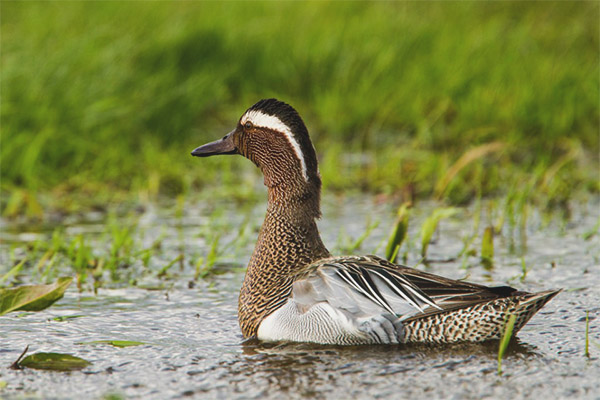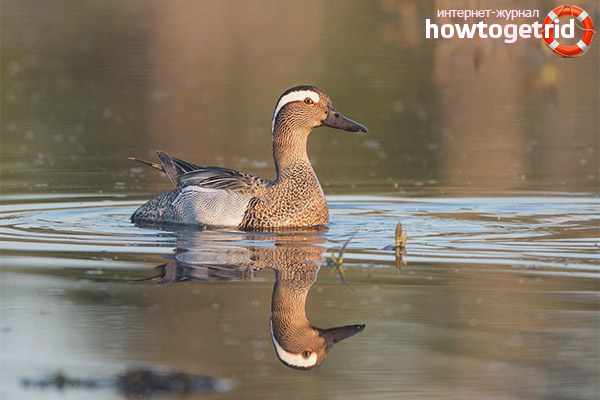The content of the article
Little duck teal-crackler is known, above all, for its unusual sonorous bang, which is heard only in the mating season. But even in their beauty, the drakes are not inferior to other members of the duck family, and even surpass them. Even their paired statues decorate many homes, as it is believed that they bring love and well-being into the house.
Duck travelers
Teals - a kind of migratory. They are able to withstand the journey for great distances, and spend the winter in the south of the Sahara, departing from the northern or northeastern regions of Russia. In the European part they are rarely seen. For example, in Italy, the population is at a level of up to 350 pairs, but wintering is not natural.
After wintering in foreign lands, they return home later than all of the duck breed. Residents from the Western European zone arrive in March.But the birds of the northern and eastern regions cross their territories only in the middle of May.
These miniature ducks find shelter on the shores of shallow ponds or marshes, rivers or lakes, so that it must be covered with tall grass - basically it should be sedge or reed. Thickets are needed to make it a safe place for shelter and convenient nesting. Rarely, but still they are settled by the sea or on arable land, although they belong to lake species of birds.
These cod-teal fly quickly, constantly maneuvering, and if it is necessary to sit on the water surface, do it elegantly, easily and quietly, without sound. Takeoff occurs vertically, without a takeoff. But, if this species is compared with such as a teal-whistle, then it is noticeable that during takeoff, the body of the crackler is not so perpendicular to the surface of the earth. And yet they have a poorly developed sense of caution, which is why they often pay with their lives.
Differences in appearance
The drake has a dark-colored head, and it has a wide snow-white under-edge strip, which is noticeable in the mating season. The eyes are brown. The chest is also brown, with a noticeable scaly pattern. White belly. Wings differ in gray-blue hues of plumage, with a “mirror” of gray-green color. They are without much gloss, with a border of white color.
But drakes have an amazing feature. When the marriage time comes to an end, and this is usually the summer time, the drakes begin to fade, all the elegant plumage disappears. And then they become like their girlfriends. Only the colored wings remain unchanged. The upper part of the body looks monotonous, and the bottom has dark mottled lines that look vague. And there are no noticeable and attractive white stripes, turning into brown, but rather light. They are located the same as in females: they pass from the beak, crossing the eye zone.
In both sexes:
- in the area of the chin and neck, the plumage is much lighter;
- the beak is expanded, has a dark gray color;
- brown tail, there is also a white underhill, black mottles visible on it;
- legs are gray.
The female is not so bright and attractive.Its plumage is brown, dark markings, there are bright specks. Does not shine grayish-green shades "mirror". The chest and abdomen are dull white with dark patches. But stand out in red color goiter and side.
The younger generation is difficult to distinguish from the formed females, but there are minor differences:
- flank and breast are reddish;
- variegates of a contrasting color are visible on the plumage of the abdomen.
Mating season and offspring
The maturation of teals is uneven. Some are already able to have offspring by the age of one, others, while in the wintering place, miss this time, postponing their first mating season. For these ducks, monogamy is a habitual way of life, and therefore they fly in pairs, and only during a mass flight create a small flock.
The crackling teens that returned after wintering tend to extend their kin, which means that their marriage period begins. The main role here is drake. Usually everything happens on the reservoirs where the birds are most comfortable.
The male begins to actively attract female. It is difficult not to notice his efforts, because the gentleman, in addition to an unusual noticeable and very beautiful color, has plumped plumage on the top of his head, his shoulders proudly sticking out.Periodically, he lowers his beak into the water, throws his neck up, tilting his head on his back or shaking it up and down. Less active slightly raise the wing, lowering the head sideways. To achieve location, drakes begin to quickly flap their wings, rising above the water.
But the female during this crucial period is more restrained. She may shake her head slightly or begin to clean the feathers that are behind her wings.
It was during this period that the drake makes such unusual sounds that people associate with the crackle of a dried-up tree. But the sounds of the crackers are sharper and louder. In females, voices are the same as in other types of ducks - the usual sonorous quacking.
After the mating season, there comes a time for laying eggs. This happens in April or May. Complete clutch contains up to 12 eggs, but usually there are not more than 9. They have such colors - light fawn or yellowish-brown.
Hatching lasts three weeks. When the chicks appear, they very quickly leave the nest, but they begin to fly late — by the age of 40 days. In the year of these ducks may be only one clutch.
Diversity in nutrition
The diet of teal-creeper is varied. He prefers not only plant food, but also animal. He extracts food from the surface of the water, but can partially dive into the water, but does not dive.
In the spring, when birds participate in mating games, create couples, raise offspring, and in summer mollusks are their favorite delicacy. But if it so happened that they were not in the place chosen for habitation, ducks feed on those insects that usually live near water bodies. They also like all kinds of lichnki, leeches and worms.
They also eat fish fry, tadpoles, amphibians, which are at the stage of caviar, crustaceans.
From plant foods in the spring, ducks, first of all, eat the vegetative part of such plants as hornolodnik and valisneria. In the Resuha and Ezhegolovnika they are attracted primarily by the seeds that they peck out.
- sedges;
- mountaineer bird, pochechuynogo;
- urchin;
- rice;
- sorrel and others
Arriving on arable land, ducks collect seeds and grains here.
Recently the populations of these miniature defenseless ducks have noticeably decreased. The unfavorable environmental conditions are to blame for this, and the poor situation in those places where the birds have to spend the winter. Hunters also destroy them, most of all for the sake of sports interest, proving to themselves skill. Often, whole clutches die when the nest is on a meadow and grass is mowed.
Video: teal - whistle and crackle













To send